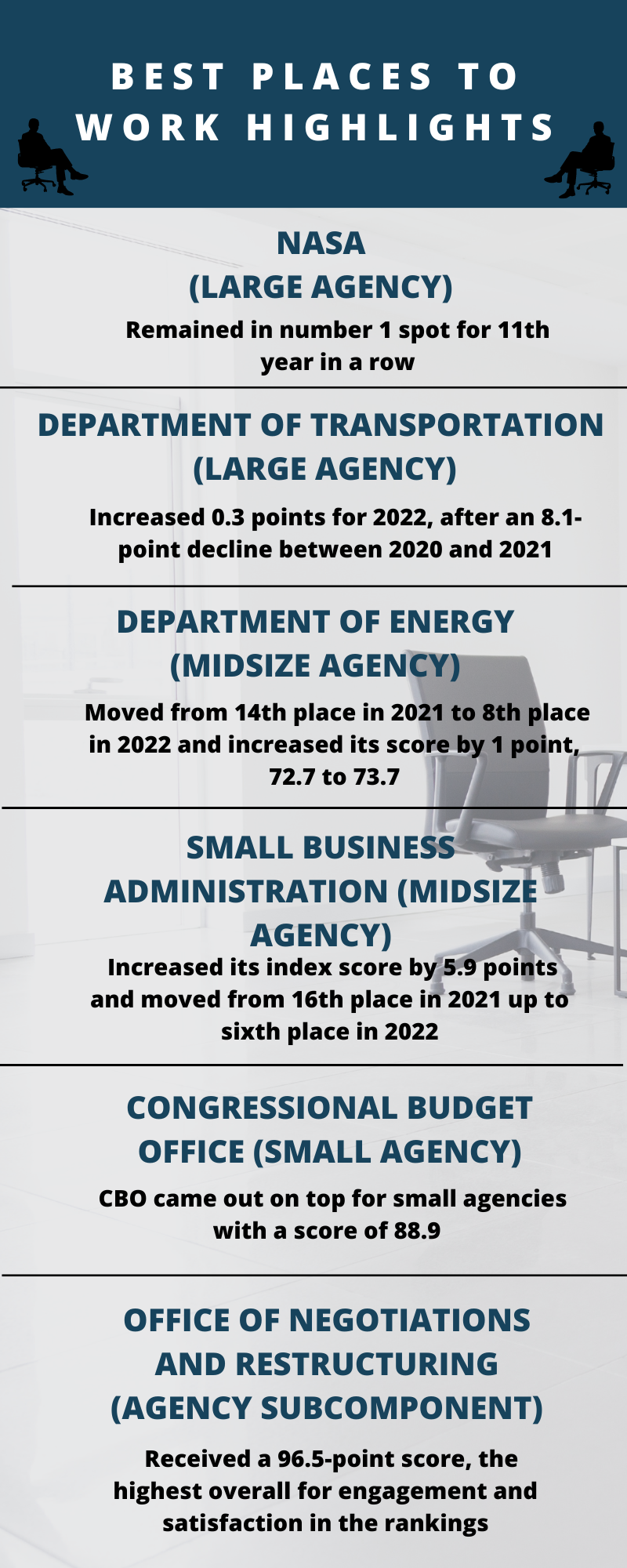
First Look
Agencies get first look into the 2022 Best Places to Work rankings
The Partnership for Public Service's list of the top 10 "Best Places to Work" large agencies is mostly unchanged, but many of the employee engagement and satisf...
For many federal agencies, employee engagement and satisfaction scores continued to slip in the 2022 Best Places to Work in the Federal Government rankings.
In a preview of the 2022 Best Places to Work that the Partnership for Public Service and Boston Consulting Group published Wednesday, the organizations unveiled the top 10 agencies for large, midsize and small agencies, as well as agency subcomponents.
“Our government faces daunting challenges and tremendous opportunities in the coming year at a time when public trust in government remains low,” said Max Stier, president and CEO of the Partnership for Public Service, in a press statement. “Having a highly motivated and engaged workforce is critical for rebuilding that trust through an effective government. These top agencies set the standard for employee engagement in the federal government.”
There was minimal shake-up in the order of the Best Places to Work rankings for large agencies — the 10 highest-ranked agencies from the 2021 rankings maintained a top 10 spot in 2022.
It came as little surprise that NASA once again ranked number one for large agencies, now for the 11th year in a row. NASA’s engagement and satisfaction score was 10 points above that of the Department of Health and Human Services, the large agency in second place. The Intelligence Community and the Department of Commerce swapped third and fourth place since last year’s rankings.
Workforce leaders from some of the more successful agencies in the rankings, though, have said that looking at internal trends for an agency is more important than the agency’s placement in the rankings for Best Places to Work.
“The rankings and accompanying data provide a means of holding federal leaders accountable for the health of their organizations, shining the spotlight on agencies that are successfully engaging employees as well as on those that are falling short,” the Partnership said in the preview report of the 2022 Best Places to Work rankings.
Despite maintaining its status at the top of the list, NASA’s overall score fell from 85.1 in 2021 to 84.3 in 2022, a further decrease since its score of in 86.6 in 2020.
NASA wasn’t the only agency on a decline, either. Many of the index scores for the 2022 Best Places to Work rankings continued on a downward trend. The departments of the Air Force and Transportation were the only two of the top 10 large agencies to increase their scores on the engagement and satisfaction index.
In comparison, the Department of Veterans Affairs was the only large agency to increase its score in 2021.

The Partnership’s rankings use data from the Office of Personnel Management’s Federal Employee Viewpoint Survey (FEVS) to create the list each year. The Partnership uses employees’ responses to three different questions in the survey to create the score index, and ultimately determine the rankings:
- I recommend my organization as a good place to work.
- Considering everything, how satisfied are you with your job?
- Considering everything, how satisfied are you with your organization?
For the Transportation Department, which ranked sixth in 2022 for large agencies, the employee engagement and satisfaction index score increased by 0.3 points, now sitting at 68.3 points. The leveling out came after the agency took an 8.1-point hit between 2020 and 2021.
Out of the top 10 large agencies, the Department of Commerce saw the steepest drop in its overall score, going from 73.7 in 2021 to 70.6 in 2022 — a 3.1-point decline.
The reason behind the generally declining scores is difficult to pinpoint, but based on analysis of FEVS results from OPM, some of the more influential factors determining employee engagement may be changes to work environment, such as return-to-office plans and hybrid work schedules, as well as perceptions of agency supervisors and recognition of a job well done.
The top 10 midsize agencies also had a relatively unchanged order in the 2022 rankings and faced drops similar to those of large agencies for employees’ engagement and satisfaction.
The Government Accountability Office and the National Science Foundation maintained their spots as the top two midsize agencies, but both agencies’ index scores declined. GAO’s score decreased by 2.2 points, while NSF’s score dropped by 3.2 points.
But one midsize agency — the Small Business Administration — significantly increased its index score by 5.9 points. SBA also moved up 10 slots in the rankings, from 16th in 2021, to sixth in 2022.
SBA’s significant score increase came only second to the Office of the General Counsel, a subcomponent of the Education Department. That office saw a 6.2-point increase in its overall index score.
For small agencies, the Congressional Budget Office came out on top with a score of 88.9.
Unlike large and midsize agencies, the Pension Benefit Guaranty Corporation and Office of Special Counsel — two small agencies near the top of the list — both saw increasing scores from 2021 to 2022.
Small agencies in general tend to receive higher engagement and satisfaction scores in both FEVS and the Best Places to Work rankings.
Notably, the U.S. International Development Finance Corporation moved from 16th place in 2021, up to the ninth spot for 2022. The agency has also had a steep increase in its engagement and satisfaction score, now at 74.1, and 13.5 points ahead of its score of 60.6 in 2020.
The Office of Negotiations and Restructuring, housed within the Pension Benefit Guaranty Corporation, had a 96.5-point engagement and satisfaction score, the highest overall score in the 2022 rankings.
On the lower end for small agencies, the Peace Corps and National Transportation Safety Board both dropped below the top 10 list, after securing the ninth and 10th place spots in 2021.
The Partnership will release the full list of the Best Places to Work, and hold a ceremony for the rankings, on April 12. You can find all of the Partnership’s top 10 Best Places to Work lists here.
Copyright © 2024 Federal News Network. All rights reserved. This website is not intended for users located within the European Economic Area.
Drew Friedman is a workforce, pay and benefits reporter for Federal News Network.
Follow @dfriedmanWFED
Related Stories





